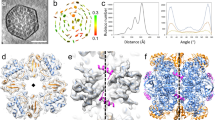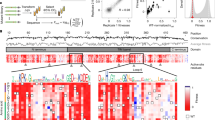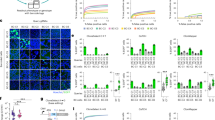Abstract
Ribulose-1,5-bisphosphate carboxylase/oxygenase (RubisCO) is a key enzyme of the Calvin cycle, which is responsible for most of Earth’s primary production. Although research on RubisCO genes and enzymes in plants, cyanobacteria and bacteria has been ongoing for years, still little is understood about its regulation and activation in bacteria. Even more so, hardly any information exists about the function of metagenomic RubisCOs and the role of the enzymes encoded on the flanking DNA owing to the lack of available function-based screens for seeking active RubisCOs from the environment. Here we present the first solely activity-based approach for identifying RubisCO active fosmid clones from a metagenomic library. We constructed a metagenomic library from hydrothermal vent fluids and screened 1056 fosmid clones. Twelve clones exhibited RubisCO activity and the metagenomic fragments resembled genes from Thiomicrospira crunogena. One of these clones was further analyzed. It contained a 35.2 kb metagenomic insert carrying the RubisCO gene cluster and flanking DNA regions. Knockouts of twelve genes and two intergenic regions on this metagenomic fragment demonstrated that the RubisCO activity was significantly impaired and was attributed to deletions in genes encoding putative transcriptional regulators and those believed to be vital for RubisCO activation. Our new technique revealed a novel link between a poorly characterized gene and RubisCO activity. This screen opens the door to directly investigating RubisCO genes and respective enzymes from environmental samples.
Similar content being viewed by others
Log in or create a free account to read this content
Gain free access to this article, as well as selected content from this journal and more on nature.com
or
Accession codes
References
Berg IA . (2011). Ecological aspects of the distribution of different autotrophic CO2 fixation pathways. Appl Environ Microbiol 77: 1925–1936.
Bradford MM, Williams WL . (1976). New, rapid, sensitive method for protein determination. Fed Proc 35: 274–274.
Dobrinski KP, Longo DL, Scott KM . (2005). The carbon concentrating mechanism of the hydrothermal vent chemolithoautotroph Thiomicrospira crunogena. J Bacteriol 187: 5761–5766.
Ellis RJ . (1979). Most abundant protein in the world. Trends Biochem Sci 4: 241–244.
Field CB, Behrenfeld MJ, Randerson JT, Falkowski P . (1998). Primary production of the biosphere: integrating terrestrial and oceanic components. Science 281: 237–240.
Gabor EM, Alkema WB, Janssen DB . (2004). Quantifying the accessibility of the metagenome by random expression cloning techniques. Environ Microbiol 6: 879–886.
Hayashi NR, Arai H, Kodama T, Igarashi Y . (1997). The novel genes, cbbQ and cbbO, located downstream from the RubisCO genes of Pseudomonas hydrogenothermophila, affect the conformational states and activity of RubisCO. Biochem Biophys Res Commun 241: 565–569.
Hayashi NR, Arai H, Kodama T, Igarashi Y . (1999). The cbbQ genes, located downstream of the form I and form II RubisCO genes, affect the activity of both RubisCOs. Biochem Biophys Res Commun 265: 177–183.
Jakob R, Saenger W . (1985). Reversed phase ion pair chromatographic separation of ribulose-1,5-bisphosphate from 3-phosphoglycerate and its application as a new enzyme assay for Rubp carboxylase oxygenase. FEBS Lett 183: 111–114.
Jannasch HW, Wirsen CO, Nelson DC, Robertson LA . (1985). Thiomicrospira crunogena sp. nov. a colorless, sulfur-oxidizing bacterium from a deep-sea hydrothermal vent. Int J Syst Bacteriol 35: 422–424.
Joshi GS, Romagnoli S, Verberkmoes NC, Hettich RL, Pelletier D, Tabita FR . (2009). Differential accumulation of form I RubisCO in Rhodopseudomonas palustris CGA010 under photoheterotrophic growth conditions with reduced carbon sources. J Bacteriol 191: 4243–4250.
Kusian B, Bowien B . (1997). Organization and regulation of cbb CO2 assimilation genes in autotrophic bacteria. FEMS Microbiol Rev 21: 135–155.
Li LA, Gibson JL, Tabita FR . (1993). The Rubisco activase (rca) gene is located downstream from rbcS in Anabaena sp. strain CA and is detected in other Anabaena/Nostoc strains. Plant Mol Biol 21: 753–764.
Maddocks SE, Oyston PCF . (2008). Structure and function of the LysR-type transcriptional regulator (LTTR) family proteins. Microbiology 154: 3609–3623.
Melchert B, Devey CW, German CR, Lackschewitz KS, Seifert R, Walter M et al. (2008). First evidence for high-temperature off-axis venting of deep crustal/mantle heat: the Nibelungen hydrothermal field, southern Mid-Atlantic Ridge. Earth Planet Sci Lett 275: 61–69.
Mueller-Cajar O, Stotz M, Wendler P, Hartl FU, Bracher A, Hayer-Hartl M . (2011). Structure and function of the AAA+ protein CbbX, a red-type Rubisco activase. Nature 479: 194–199.
Perner M, Seifert R, Weber S, Koschinsky A, Schmidt K, Strauss H et al. (2007). Microbial CO2 fixation and sulfur cycling associated with low-temperature emissions at the Lilliput hydrothermal field, southern Mid-Atlantic Ridge (9.S). Environ Microbiol 9: 1186–1201.
Perner M, Bach W, Hentscher M, Koschinsky A, Garbe-Schonberg D, Streit WR et al. (2009). Short-term microbial and physico-chemical variability in low-temperature hydrothermal fluids near 5°S on the Mid-Atlantic Ridge. Environ Microbiol 11: 2526–2541.
Perner M, Ilmberger N, Köhler HU, Chow J, Streit WR . (2011). Emerging fields in functional metagenomics and its industrial relevance - overcoming limitations and redirecting the search for novel biocatalysts. In de Bruijn FJ, (ed) Handbook of Molecular Microbial Ecology II: Metagenomics in Different Habitats. John Wiley & Sons, Inc.: Hoboken, NJ.
Perner M, Hansen M, Seifert R, Strauss H, Koschinsky A, Petersen S . (2013). Linking geology, fluid chemistry, and microbial activity of basalt- and ultramafic-hosted deep-sea hydrothermal vent environments. Geobiology 11: 340–355.
Portis AR Jr . (1990). Rubisco activase. Biochim Biophys Acta 1015: 15–28.
Portis AR Jr . (2003). Rubisco activase - Rubisco's catalytic chaperone. Photosynth Res 75: 11–27.
Raven JA . (2009). Contributions of anoxygenic and oxygenic phototrophy and chemolithotrophy to carbon and oxygen fluxes in aquatic environments. Aquat Microb Ecol 56: 177–192.
Raven JA . (2013). Rubisco: still the most abundant protein of Earth? New Phytol 198: 1–3.
Rondon M, Raffel S, Goodman R, Handelsman J . (1999). Toward functional genomics in bacteria: analysis of gene expression in Escherichia coli from a bacterial artificial chromosome library of Bacillus cereus. Proc Natl Acad Sci USA 96: 6451–6455.
Schell MA . (1993). Molecular biology of the LysR family of transcriptional regulators. Annu Rev Microbiol 47: 597–626.
Schwedock J, Harmer TL, Scott KM, Hektor HJ, Seitz AP, Fontana MC et al. (2004). Characterization and expression of genes from the RubisCO gene cluster of the chemoautotrophic symbiont of Solemya velum: cbbLSQO. Arch Microbiol 182: 18–29.
Scott KM, Sievert SM, Abril FN, Ball LA, Barrett CJ, Blake RA et al. (2006). The genome of deep-sea vent chemolithoautotroph Thiomicrospira crunogena XCL-2. PLoS Biol 4: 2196–2212.
Tabita FR . (1999). Microbial ribulose-1,5-bisphosphate carboxylase/oxygenase: a different perspective. Photosynth Res 60: 1–28.
Tabita FR, Hanson TE, Li H, Satagopan S, Singh J, Chan S . (2007). Function, structure, and evolution of the RubisCO-like proteins and their RubisCO homologs. Microbiol Mol Biol Rev 71: 576–599.
Tabita FR, Satagopan S, Hanson TE, Kreel NE, Scott SS . (2008). Distinct form I, II, III, and IV Rubisco proteins from the three kingdoms of life provide clues about Rubisco evolution and structure/function relationships. J Exp Bot 59: 1515–1524.
Takai K, Campbell BJ, Cary SC, Suzuki M, Oida H, Nunoura T et al. (2005). Enzymatic and genetic characterization of carbon and energy metabolisms by deep-sea hydrothermal chemolithoautotrophic isolates of Epsilonproteobacteria. Appl Environ Microbiol 71: 7310–7320.
Toyoda K, Yoshizawa Y, Arai H, Ishii M, Igarashi Y . (2005). The role of two CbbRs in the transcriptional regulation of three ribulose-1,5-bisphosphate carboxylase/oxygenase genes in Hydrogenovibrio marinus strain MH-110. Microbiology 151: 3615–3625.
Witte B, John D, Wawrik B, Paul JH, Dayan D, Tabita FR . (2010). Functional prokaryotic RubisCO from an oceanic metagenomic library. Appl Environ Microbiol 76: 2997–3003.
Wu J, Rosen BP . (1991). The ArsR protein is a trans-acting regulatory protein. Mol Microbiol 5: 1331–1336.
Xie W, Wang F, Guo L, Chen Z, Sievert SM, Meng J et al. (2011). Comparative metagenomics of microbial communities inhabiting deep-sea hydrothermal vent chimneys with contrasting chemistries. ISME J 5: 414–426.
Acknowledgements
We thank the captain and crews of the RV Meteor as well as the ROV Kiel6000 (GEOMAR, Kiel) for helping us to obtain deep-sea vent samples. We thank Wenke Bahnsen and Nicole Adam for excellent technical assistance in the laboratory and Wolfgang R Streit for stimulating discussions and suggestions during the work. This work was supported by grants from the Deutsche Forschungsgemeinschaft (DFG) (PE1549/5-1) and the DFG priority program 1144 ‘From Mantle to Ocean: Energy-, Material- and Life-cycles at Spreading Axes’.
Author information
Authors and Affiliations
Corresponding author
Ethics declarations
Competing interests
The authors declare no conflict of interest.
Additional information
Supplementary Information accompanies this paper on The ISME Journal website
Supplementary information
Rights and permissions
About this article
Cite this article
Böhnke, S., Perner, M. A function-based screen for seeking RubisCO active clones from metagenomes: novel enzymes influencing RubisCO activity. ISME J 9, 735–745 (2015). https://doi.org/10.1038/ismej.2014.163
Received:
Revised:
Accepted:
Published:
Issue date:
DOI: https://doi.org/10.1038/ismej.2014.163
This article is cited by
-
Current status of carbon monoxide dehydrogenases (CODH) and their potential for electrochemical applications
Bioresources and Bioprocessing (2023)
-
Investigation of cold-active and mesophilic cellulases: opportunities awaited
Biomass Conversion and Biorefinery (2023)
-
Horizontal acquisition of hydrogen conversion ability and other habitat adaptations in the Hydrogenovibrio strains SP-41 and XCL-2
BMC Genomics (2019)
-
Seeking active RubisCOs from the currently uncultured microbial majority colonizing deep-sea hydrothermal vent environments
The ISME Journal (2019)
-
Novel hydrogenases from deep-sea hydrothermal vent metagenomes identified by a recently developed activity-based screen
The ISME Journal (2018)



